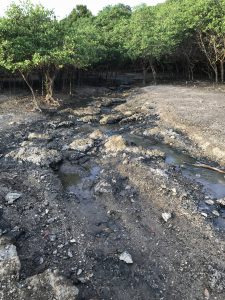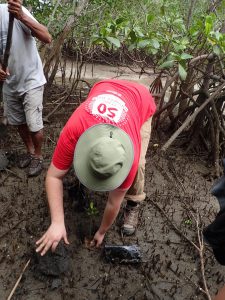After being on campus for while after tropical storm Nate, we were finally able to go on another trip. This time we went down to the Pacific Coast and visited the mangrove forests. Mangroves are the only forests that are capable of surviving so close to the ocean, and they host an abundance of aquatic organisms. What makes mangroves so cool is their various adaptations that allow them to colonize the extremely salty and wet conditions of the seaside.
Mangroves are also called halophytes which is another name for salt adapted trees and shrubs. In order to survive, they have to be able to filter salt and cope with immersion and wave action.
Red mangroves are able to prop themselves up on their roots like stilts. This helps them stay above the water level which enables the mangroves to absorb gases even during high tide. Other mangroves also make pneumatophores. These are little “breathing tubes” that stick out of the water during high tide. Many of the mangroves we saw in La Ensanada had these. They are covered in lenticels which allow for gas exchange. Mangroves also use their roots to prevent themselves from absorbing too much salt. Because their roots are so impenetrable they actually filter over 90% of the salt from the water that’s absorbed.
The trees have really amazing dispersal systems. The seeds look an awful lot like skinny zucchinis. They germinate while still attached to the mother plant, so they have started growing even
before they have been planted. They then float in the ocean until they find a suitable spot to root. The seeds normally float horizontally in the water which seems like it would make it difficult to stick in the ground and root. Mangroves have adapted to this. When a seed finds a suitable habitat, it will absorb water to change its density. It then floats vertically in the water which enables them to stick into the ground and resume growing. They can even reverse this process if the area turns out to be a poor environment.
Given all of their adaptation, mangrove forests are still threatened. People are constantly cutting them down to make beach resorts. This not only destroys the mangroves, but also ruins the habitat that supports many burrowing mollusks. Given the threat of climate
change, and how much carbon is stored in the soil of mangrove forests, we should be actively trying to inform the public, so they are more likely to be protected.





